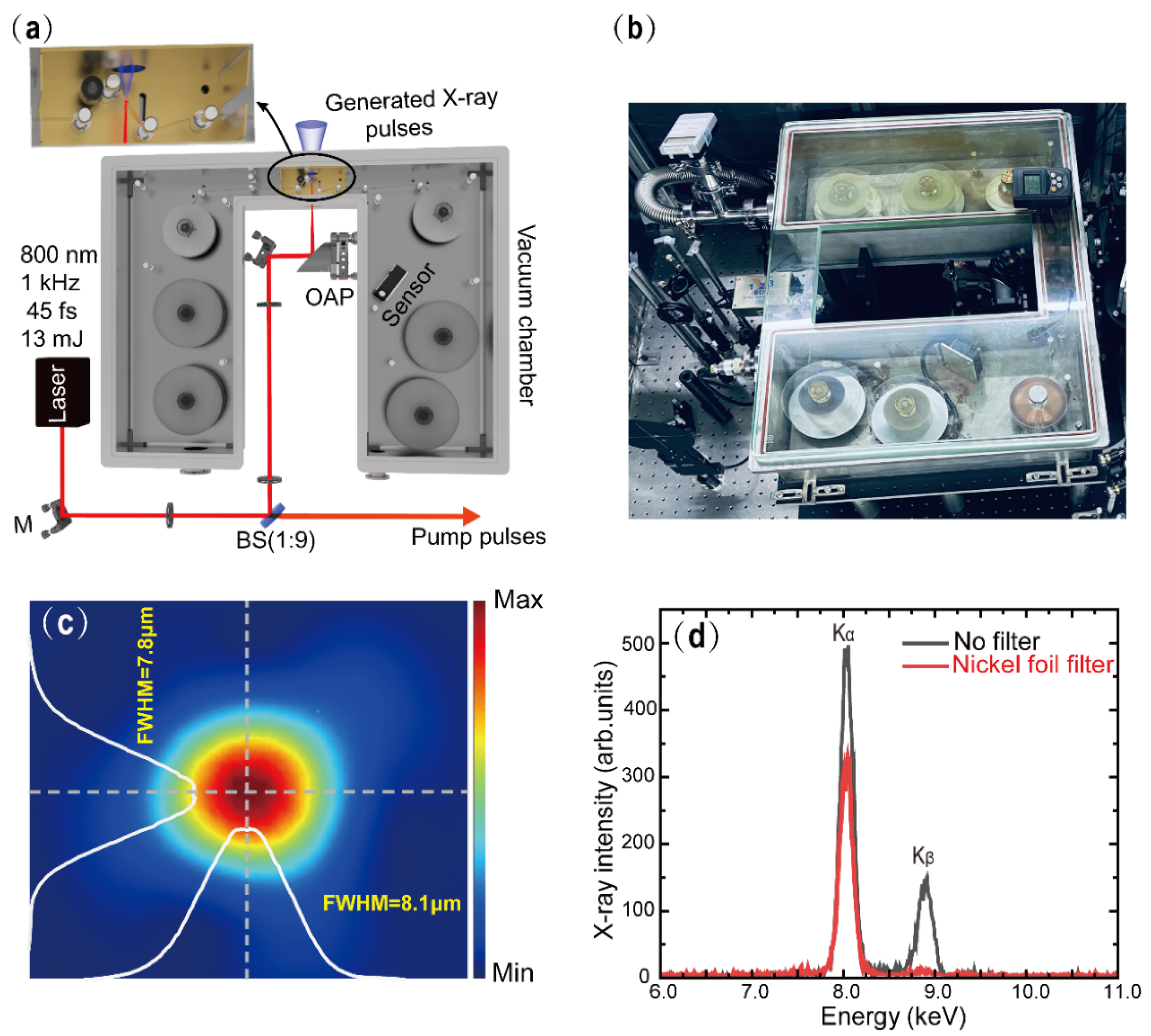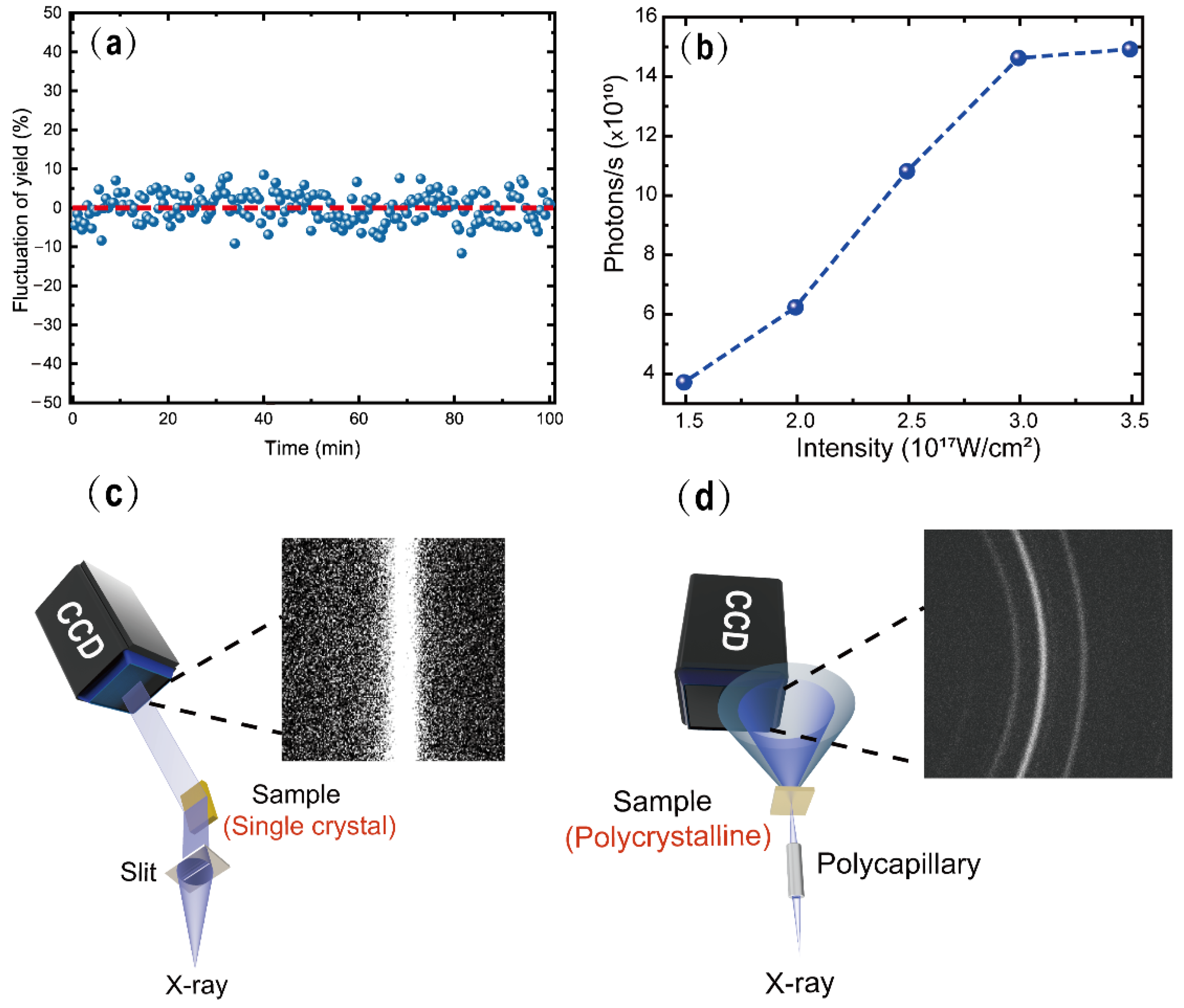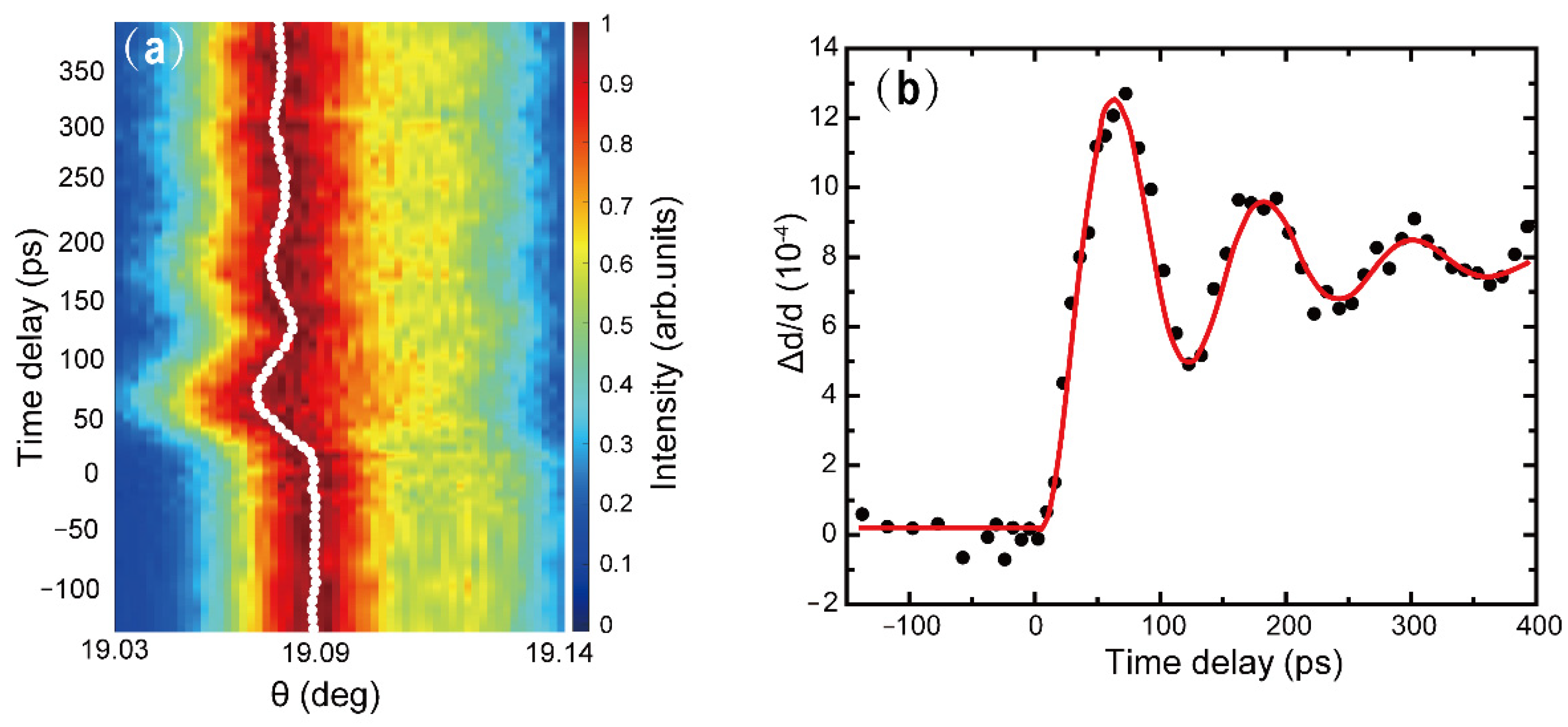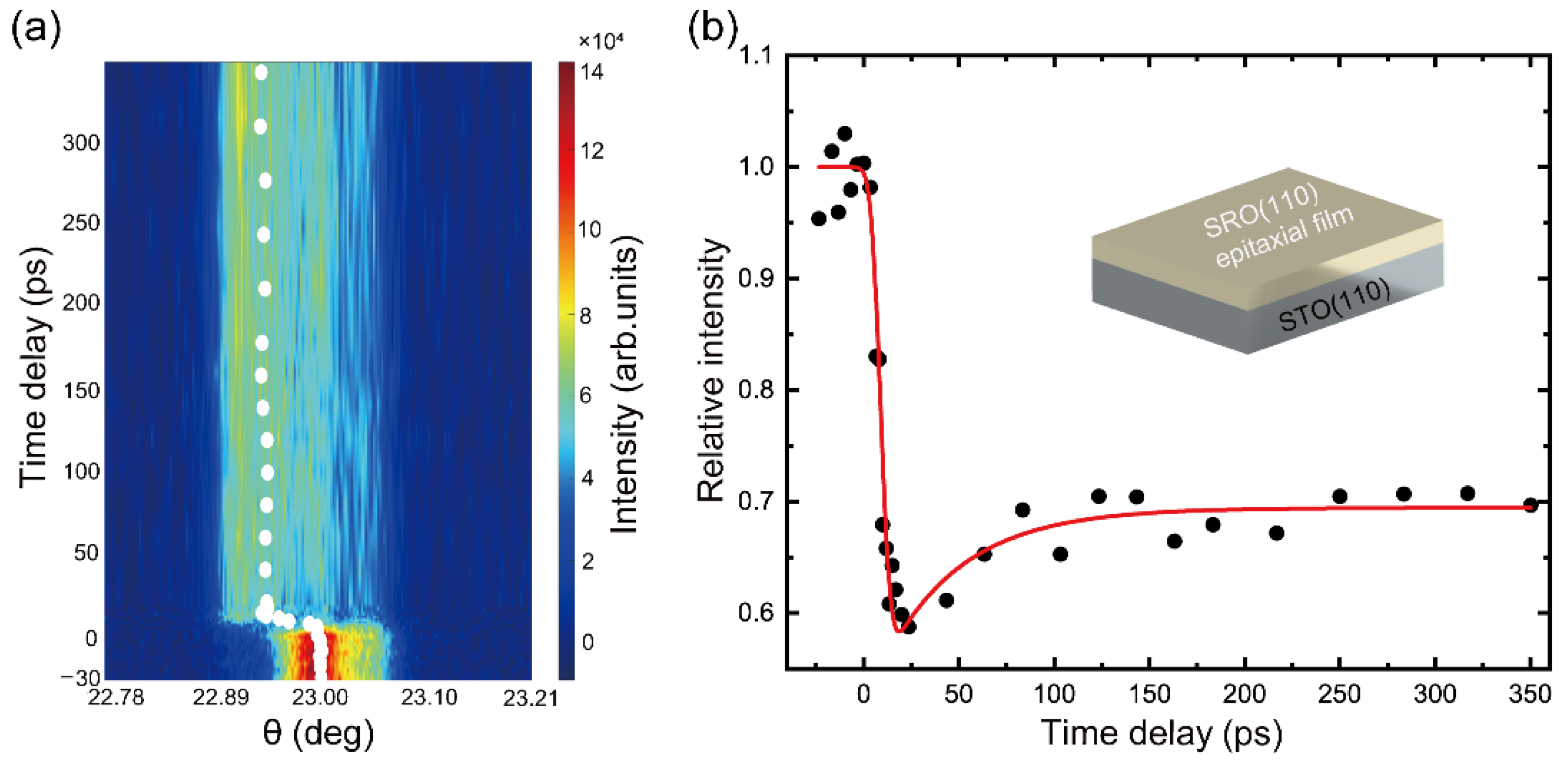A Highly Stable-Output Kilohertz Femtosecond Hard X-ray Pulse Source for Ultrafast X-ray Diffraction
Abstract
:1. Introduction
2. Results and Discussion
2.1. Optimization of the Laser-Plasma-Based Hard X-ray Pulse Source
2.2. Ultrafast X-ray Diffraction Measurements
3. Conclusions
Author Contributions
Funding
Acknowledgments
Conflicts of Interest
References
- Zhang, H.; Zhang, Y.; Li, R.; Yu, J.; Dong, W.; Chen, C.; Wang, K.; Tang, X.; Chen, J. Room temperature hidden state in a manganite observed by time-resolved X-ray diffraction. Npj Quantum Mater. 2019, 4, 31. [Google Scholar] [CrossRef]
- Rousse, A.; Rischel, C.; Fourmaux, S.; Uschmann, I.; Sebban, S.; Grillon, G.; Balcou, P.; Förster, E.; Geindre, J.P.; Audebert, P.; et al. Non-thermal melting in semiconductors measured at femtosecond resolution. Nature 2001, 410, 65–68. [Google Scholar] [CrossRef] [PubMed]
- Sokolowski-Tinten, K.; Blome, C.; Dietrich, C.; Tarasevitch, A.; von Hoegen, M.H.; von der Linde, D.; Cavalleri, A.; Squier, J.; Kammler, M. Femtosecond X-ray measurement of ultrafast melting and large acoustic transients. Phys. Rev. Lett. 2001, 87, 225701. [Google Scholar] [CrossRef] [PubMed] [Green Version]
- Schick, D.; Bojahr, A.; Herzog, M.; Gaal, P.; Vrejoiu, I.; Bargheer, M. Following strain-induced mosaicity changes of ferroelectric thin films by ultrafast reciprocal space mapping. Phys. Rev. Lett. 2013, 110, 095502. [Google Scholar] [CrossRef] [Green Version]
- Schick, D.; Herzog, M.; Wen, H.; Chen, P.; Adamo, C.; Gaal, P.; Schlom, D.G.; Evans, P.G.; Li, Y.; Bargheer, M. Localized excited charge carriers generate ultrafast inhomogeneous strain in the multiferroic BiFeO3. Phys. Rev. Lett. 2014, 112, 097602. [Google Scholar] [CrossRef] [Green Version]
- Schoenleins, R.W.; Chattopadhyay, S.; Chong, H.H.W.; Glover, T.E.; Heimann, P.A.; Shank, C.V.; Zholents, A.A.; Zolotorev, M.S. Generation of femtosecond pulses of synchrotron radiation. Science 2000, 287, 2237–2240. [Google Scholar] [CrossRef] [Green Version]
- Ishikawa, T.; Aoyagi, H.; Asaka, T.; Asano, Y.; Azumi, N.; Bizen, T.; Kumagai, N. A compact X-ray free-electron laser emitting in the sub-ångström region. Nat. Photonics 2012, 6, 540–544. [Google Scholar] [CrossRef]
- Marangos, J.P. Introduction to the new science with X-ray free electron lasers. Contemp. Phys. 2011, 52, 551–569. [Google Scholar] [CrossRef]
- Lu, W.; Nicoul, M.; Shymanovich, U.; Brinks, F.; Afshari, M.; Tarasevitch, A.; von der Linde, D.; Sokolowski-Tinten, K. Acoustic response of a laser-excited polycrystalline Au-film studied by ultrafast Debye–Scherrer diffraction at a table-top short-pulse X-ray source. AIP Adv. 2020, 10, 035015. [Google Scholar] [CrossRef]
- Guo, X.; Jiang, Z.; Chen, L.; Chen, M.L.; Xin, J.; Rentzepis, P.M.; Chen, J. Ultrafast structural dynamics studied by kilohertz time-resolved X-ray diffraction. Chin. Phys. B 2015, 24, 108701. [Google Scholar] [CrossRef]
- Bargheer, M.; Zhavoronkov, N.; Woerner, M.; Elsaesser, T. Recent progress in ultrafast X-ray diffraction. Chemphyschem A Eur. J. Chem. Phys. Phys. Chem. 2006, 7, 783–792. [Google Scholar] [CrossRef] [PubMed]
- Zamponi, F.; Ansari, Z.; Schmising, C.V.K.; Rothhardt, P.; Zhavoronkov, N.; Woerner, M.; Elsaesser, T.; Bargheer, M.; Trobitzsch-Ryll, T.; Haschke, M. Femtosecond hard X-ray plasma sources with a kilohertz repetition rate. Appl. Phys. A 2009, 96, 51–58. [Google Scholar] [CrossRef]
- Silies, M.; Witte, H.; Linden, S.; Kutzner, J.; Uschmann, I.; Förster, E.; Zacharias, H. Table-top kHz hard X-ray source with ultrashort pulse duration for time-resolved X-ray diffraction. Appl. Phys. A 2009, 96, 59–67. [Google Scholar] [CrossRef]
- Hagedorn, M.; Kutzner, J.; Tsilimis, G.; Zacharias, H. High-repetition-rate hard X-ray generation with sub-millijoule femtosecond laser pulses. Appl. Phys. B 2003, 77, 49–57. [Google Scholar] [CrossRef]
- Korn, G.; Thoss, A.; Stiel, H.; Vogt, U.; Richardson, M. Ultrashort 1-kHz laser plasma hard X-ray source. Opt. Lett. 2002, 27, 866–868. [Google Scholar] [CrossRef]
- Zhavoronkov, N.; Gritsai, Y.; Korn, G.; Elsaesser, T. Ultra-short efficient laser-driven hard X-ray source operated at a kHz repetition rate. Appl. Phys. B 2004, 79, 663–667. [Google Scholar] [CrossRef]
- Koç, A.; Hauf, C.; Woerner, M.; Grafenstein, L.; Ueberschaer, D.; Bock, M.; Griebner, U.; Elsaesser, T. Compact high-flux hard X-ray source driven by femtosecond mid-infrared pulses at a 1 kHz repetition rate. Opt. Lett. 2021, 46, 210–213. [Google Scholar] [CrossRef]
- Weisshaupt, J.; Juvé, V.; Holtz, M.; Ku, S.; Woerner, M.; Elsaesser, T.; Ališauskas, S.; Pugžlys, A.; Baltuška, A. High-brightness table-top hard X-ray source driven by sub-100-femtosecond mid-infrared pulses. Nat. Photonics 2014, 8, 927–930. [Google Scholar] [CrossRef]
- Chen, L.M.; Kando, M.; Xu, M.H.; Li, Y.T.; Koga, J.; Chen, M.; Xu, H.; Yuan, X.H.; Dong, Q.L.; Sheng, Z.M.; et al. Study of X-ray emission enhancement via a high-contrast femtosecond laser interacting with a solid foil. Phys. Rev. Lett. 2008, 100, 045004. [Google Scholar] [CrossRef] [Green Version]
- Gibbon, P.; Bell, A.R. Collisionless absorption in sharp-edged plasmas. Phys. Rev. Lett. 1992, 68, 1535. [Google Scholar] [CrossRef]
- Zhu, C.; Tan, J.; He, Y.; Wang, J.; Li, Y.; Lu, X.; Li, Y.; Chen, J.; Chen, M.L.; Zhang, J. Ultrafast structural dynamics using time-resolved X-ray diffraction driven by relativistic laser pulses. Chin. Phys. B 2021, 30, 098701. [Google Scholar] [CrossRef]
- Chen, L.M.; Zhang, J.; Dong, Q.L.; Teng, H.; Liang, T.J.; Zhao, L.Z.; Wei, Z.Y. Hot electron generation via vacuum heating process in femtosecond laser–solid interactions. Phys. Plasmas 2001, 8, 2925–2929. [Google Scholar] [CrossRef] [Green Version]
- Chen, J.; Chen, W.K.; Tang, J. Time-resolved structural dynamics of thin metal films heated with femtosecond optical pulses. Proc. Nat. Acad. Sci. USA 2011, 108, 18887–18892. [Google Scholar] [CrossRef] [PubMed] [Green Version]
- Chen, J.; Chen, W.K.; Tang, J.; Rentzepis, P.M. Hot electrons blast wave generated by femtosecond laser pulses on thin Au(1 1 1) crystal, monitored by subpicosecond X-ray diffraction. Chem. Phys. Lett. 2006, 419, 374–378. [Google Scholar] [CrossRef]
- Hu, J.; Karam, T.E.; Blake, G.A.; Zewail, A.H. Ultrafast lattice dynamics of single crystal and polycrystalline gold nanofilms☆. Chem. Phys. Lett. 2017, 683, 258–261. [Google Scholar] [CrossRef]
- Gan, Y.; Che, J.K. Thermomechanical wave propagation in gold films induced by ultrashort laser pulses. Mech. Mater. 2010, 42, 491–501. [Google Scholar] [CrossRef]
- Hartland, G.V.; Hu, M.; Sader, J.E. Softening of the symmetric breathing mode in gold particles by laser-induced heating. J. Phys. Chem. B 2003, 107, 7472–7478. [Google Scholar] [CrossRef]
- Schick, D.; Bojahr, A.; Herzog, M.; Shayduk, R.; Schmising, C.V.K.O.; Bargheerac, M. Udkm1Dsim—A simulation toolkit for 1D ultrafast dynamics in condensed matter. Comput. Phys. Commun. 2014, 185, 651–660. [Google Scholar] [CrossRef] [Green Version]
- Nasiri, S.; Dashti, A.; Hosseinnezhad, M.; Rabiei, M.; Palevicius, A.; Doustmohammadi, A.; Janusas, G. Mechanochromic and thermally activated delayed fluorescence dyes obtained from D–A–D′ type, consisted of xanthen and carbazole derivatives as an emitter layer in organic light emitting diodes. Chem. Eng. J. 2022, 430, 131877. [Google Scholar] [CrossRef]
- Schmising, C.V.K.; Bargheer, M.; Kiel, M.; Zhavoronkov, N.; Woerner, M.; Elsaesser, T.; Vrejoiu, I.; Hesse, D.; Alexe, M. Coupled ultrafast lattice and polarization dynamics in ferroelectric nanolayers. Phys. Rev. Lett. 2007, 98, 257601. [Google Scholar] [CrossRef] [Green Version]
- Schmising, C.V.K.; Harpoeth, A.; Zhavoronkov, N.; Ansari, Z.; Aku-Leh, C.; Woerner, M.; Elsaesser, T.; Bargheer, M.; Schmidbauer, M.; Vrejoiu, I.; et al. Ultrafast magnetostriction and phonon-mediated stress in a photoexcited ferromagnet. Phys. Rev. B 2008, 78, 060404. [Google Scholar] [CrossRef] [Green Version]
- Schick, D.; Herzog, M.; Bojahr, A.; Leitenberger, W.; Hertwig, A.; Shayduk, R.; Bargheer, M. Ultrafast lattice response of photoexcited thin films studied by X-ray diffraction. Struct. Dyn. 2014, 1, 064501. [Google Scholar] [CrossRef] [PubMed] [Green Version]




Publisher’s Note: MDPI stays neutral with regard to jurisdictional claims in published maps and institutional affiliations. |
© 2022 by the authors. Licensee MDPI, Basel, Switzerland. This article is an open access article distributed under the terms and conditions of the Creative Commons Attribution (CC BY) license (https://creativecommons.org/licenses/by/4.0/).
Share and Cite
Zhao, D.; You, P.; Yang, J.; Yu, J.; Zhang, H.; Liao, M.; Hu, J. A Highly Stable-Output Kilohertz Femtosecond Hard X-ray Pulse Source for Ultrafast X-ray Diffraction. Appl. Sci. 2022, 12, 4723. https://doi.org/10.3390/app12094723
Zhao D, You P, Yang J, Yu J, Zhang H, Liao M, Hu J. A Highly Stable-Output Kilohertz Femtosecond Hard X-ray Pulse Source for Ultrafast X-ray Diffraction. Applied Sciences. 2022; 12(9):4723. https://doi.org/10.3390/app12094723
Chicago/Turabian StyleZhao, Di, Pengxian You, Jing Yang, Junhong Yu, Hang Zhang, Min Liao, and Jianbo Hu. 2022. "A Highly Stable-Output Kilohertz Femtosecond Hard X-ray Pulse Source for Ultrafast X-ray Diffraction" Applied Sciences 12, no. 9: 4723. https://doi.org/10.3390/app12094723
APA StyleZhao, D., You, P., Yang, J., Yu, J., Zhang, H., Liao, M., & Hu, J. (2022). A Highly Stable-Output Kilohertz Femtosecond Hard X-ray Pulse Source for Ultrafast X-ray Diffraction. Applied Sciences, 12(9), 4723. https://doi.org/10.3390/app12094723




